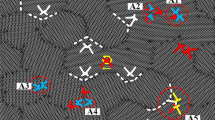Conclusions
-
1.
A study has been made of the dislocation structure of the boundary regions in crystalline composites formed by solid-phase intergrowth of individual single crystals. It has been established that the dislocation structure depends on the conditions under which the intergrown composites are formed. It has been demonstrated that crystalline composites can be obtained without increasing the density of the dislocations near the boundary, and the strength along the boundary remains equal to the strength of the bulk material.
-
2.
It has been established that the intergrowth boundary of a crystalline composite consists of two dislocation networks. One of these is a network of immobile dislocations; the other is the usual subboundary that may shift from its original position and thereby accomplish splitting of the intergrowth boundary into two structural defects.
Similar content being viewed by others
Literature cited
E. A. Stepantsov, “Contact interaction in hot-press joining of refractory oxide crystals,” Author's Abstract of Candidate's Dissertation, Moscow (1980).
E. A. Stepantsov and V. R. Regel', “Status of research on hot-press joining of crystals,” in: Ferroelectric Crystals with the Application of Various Fields [in Russian], Moscow (1981), pp. 17–23.
V. R. Regel' and E. A. Stepantsov, “On the possibility of solid-phase intergrowth of crystals,” in: 6th Conference on Processes of Growth and Synthesis of Semiconductor Crystals and Films [in Russian], Vol. 1, Novosibirsk (1982), pp. 43–50.
Yu. P. Pshenichkov, Determination of Fine Structure of Crystals [in Russian], Moscow (1974).
J. Gilman and W. Johnson, “Nucleation and growth of slip bands in lithium fluoride crystals,” in: Dislocations and Mechanical Properties of Crystals [Russian translation], Moscow (1960), pp. 79–85.
Author information
Authors and Affiliations
Additional information
Translated from Mekhanika Kompozitnykh Materialov, No. 4, pp. 697–702, July–August, 1985.
Rights and permissions
About this article
Cite this article
Regel', V.R., Stepantsov, E.A. & Tovmasyan, A.B. Boundary dislocation structure of crystalline composites. Mech Compos Mater 21, 489–493 (1986). https://doi.org/10.1007/BF00610900
Received:
Issue Date:
DOI: https://doi.org/10.1007/BF00610900



